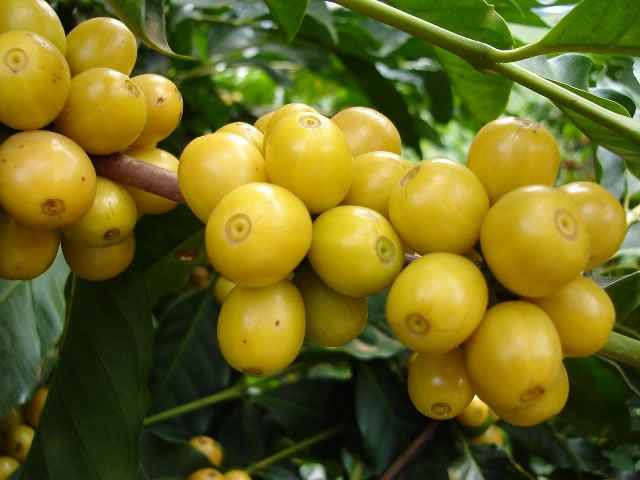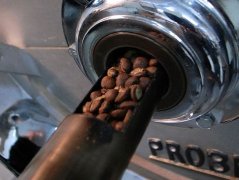The source of the sour taste of coffee the difference between pleasant acid and annoying acid.
For many beginners, coffee sour always feel a bit unacceptable…coffee taste and sour mixed together, do not think strange?
Senior as a sour people do not pay for life coffee lovers, always think sour good, sour wonderful, so ignore the voice of the majority of beginners, really damn. Today let us study the relationship between coffee and fruit acid, so that you can drink sour can also drink happy, cheeks salivation.

1. Source of sour taste: coffee cherry fruit
I think a lot of people don't know what coffee looks like originally, just like cherries, oily and shiny, and it feels delicious.
The seeds inside the red pulp are processed into green coffee beans. At this time, the green beans are green, like the seeds of ordinary plants. After roasting, they become coffee and black, and become coffee ripe beans sold on the market. As you learn from basic biology, the purpose of the pulp itself is to provide seed nutrients, so in the process of planting, the original flavor of the pulp naturally affects the flavor of the coffee beans.
So at least understand that it is reasonable for coffee to have fruit acid, even if this is the real natural state, definitely not rotten or smelly acid. After learning that sourness is not a sin in itself, try to let go of the stereotype of sourness.
The Possibility of Acidity: Comfortable Acid and Disagreeable Acid
Although sour taste is normal, it is not just sour, due to the coffee beans themselves, processing, transportation, storage, roasting, brewing and other factors, sour taste can also be divided into delicious acid, comfortable acid or unpleasant acid, nasty acid.
Quietly tasting, imagining, and comparing the sourness of coffee while drinking coffee is an important part of learning fine coffee.
Comfortable acids include: malic acid, citric acid, grapefruit acid, passion fruit acid, red wine acid, berry acid, cherry acid, citrus acid, peach acid, pineapple acid, black vinegar, red vinegar…etc. Imagine that the sourness of the fruit is naturally and characteristically present in the mouth, enriching the coffee itself, but gentle and not overly stimulating.
Annoying acids include: too strong acetic acid, smelly acid (expired), overfermented acid, stuffy acid, lactic acid (sweat acid), humic acid, etc.
If these sour tastes are placed in coffee, they will feel uncomfortable, and the generally annoying acid recognition is very high, and a little bit will spoil the whole cup of coffee, which is probably the main reason why most people have a bad impression of sour taste.

But pay special attention: the real fine grade coffee basically does not exist uncomfortable acid, these acids too seriously affect the taste, simply can not enter the fine coffee threshold. So when drinking bad coffee, if you drink disgusting acid, please don't attribute the original sin to fine coffee. After all, there are too many unscrupulous businessmen who mess around now. To ensure that their mouth is clean and clean, or to identify guaranteed fine coffee.
Important Notice :
前街咖啡 FrontStreet Coffee has moved to new addredd:
FrontStreet Coffee Address: 315,Donghua East Road,GuangZhou
Tel:020 38364473
- Prev

A detailed introduction to the cultivation of Coffee Manors in Central America
Central America knows Central America Coffee Central America is the land bridge connecting North and South America. There are seven countries, namely, Belize, Costa Rica, El Salvador, Guatemala, Honduras, Nicaragua and Panama. Seven Central American countries all produce coffee, with Guatemala, Costa Rica and Honduras among the top 10 coffee exporters in the world. Coffee began to flourish in Central America
- Next

Coffee Roasting Details Mistakes Corrections Methods Description Roasting Experience
Once you smell a whiff of smoke floating around in the coffee beans, it must be a problem with your smoke exhaust system, or a problem with the timing of your smoke control. Silver skin is a flammable substance that is easy to burn, whether it is in the silver skin collector or in the drum, and coffee beans are easy to absorb smoke, so it should be in the silver skin when it expands and falls off.
Related
- Beginners will see the "Coffee pull flower" guide!
- What is the difference between ice blog purified milk and ordinary milk coffee?
- Why is the Philippines the largest producer of crops in Liberia?
- For coffee extraction, should the fine powder be retained?
- How does extracted espresso fill pressed powder? How much strength does it take to press the powder?
- How to make jasmine cold extract coffee? Is the jasmine + latte good?
- Will this little toy really make the coffee taste better? How does Lily Drip affect coffee extraction?
- Will the action of slapping the filter cup also affect coffee extraction?
- What's the difference between powder-to-water ratio and powder-to-liquid ratio?
- What is the Ethiopian local species? What does it have to do with Heirloom native species?

